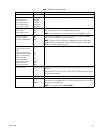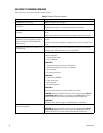C1528M-F (6/05) 101
RS-422 This is an Electronics Industry Association (EIA) interface standard. Pelco uses this standard for
communication from a controller to one or more camera receivers (on the same line); the maximum
recommended distance is 4,000 feet (1,219 m).
The four-wire connection provides two wires for transmit and two wires for receive. Pelco receiver/
driver communication uses only the two transmit wires (commands are sent from the controller to
the receiver only; the receiver does not “talk” back to the controller). Pelco keyboard communication
uses all four wires.
NOTE: The electrical communication scheme used by Pelco is a direct-coupled method, not an
AC-coupled method. Therefore, if the ground potential of the wire at its two end points is different
(other than zero volts), an additional wire is required as a ground.
RS-485 This is an Electronics Industry Association (EIA) interface standard used for communication between
multiple transmitters and receivers; the maximum recommended distance is 4,000 feet (1,219 m).
The four-wire connection provides two wires for transmit and two wires for receive.
NOTE: The electrical communication scheme used by Pelco is a direct-coupled method, not an
AC-coupled method. Therefore, if the ground potential of the wire at its two end points is different
(other than zero volts), an additional wire is required as a ground.
Scratchpad sequence A scratchpad sequence can be run on an individual system monitor, without entering the
password-protected CM6800E Matrix Switcher on-screen programming menus. You can program
scratchpad sequences from the CM6800E Matrix Switcher on-screen programming menus only, not
from the CM6800-MGR software.
Sequence Allows an operator to see a routine of 72 camera views on any system monitor, over and over again.
The sequence can be operated automatically or manually. The order in which the camera views
appear and the time each view remains can be programmed.
Standard Coaxitron This is Pelco’s Coaxitron control technology that uses 15 bits to send a command.
Star configuration This is a way of providing multiple direct connections from one source. A star configuration uses a
separate cable for each direct connection, with all of the cables connected to a central device.
When connecting PTZ cameras to a matrix switcher, for example, the central device can be a code
distribution unit, such as the CM9760-CDU-T. Each camera has a direct connection to the
CM9760-CDU-T, which is the central device.
Synchronize Since the CM6800E Matrix Switcher can be programmed from either the CM6800-MGR software or
the CM6800E Matrix Switcher on-screen programming menus, you could potentially have different
settings in the two programming sources. Pelco recommends transmitting any programming
changes from the updated programming source so that the next time you make changes from either
programming source, you will be modifying the current system settings. Refer to Transmit
Programming Settings in the CM6800-MGR Installation/Operation manual.
System keyboard This is a keyboard compatible with and connected to the matrix switcher, allowing a system
operator manual control over the system.
System reset This restores the system to the default settings, as shipped from the factory.
Vertical drive/synchronization This option sends a timing pulse from the matrix switcher to a compatible camera. The camera
aligns the vertical synchronization with the timing pulse.
Zone A zone is a user-defined, physical location to which (1) a label is attached and (2) a camera is
associated. When the associated camera is panned through or remains within this defined zone, the
zone label appears on the monitor. With some camera systems, a zone can be blanked to prevent
viewing while the camera is positioned in the zone.


















